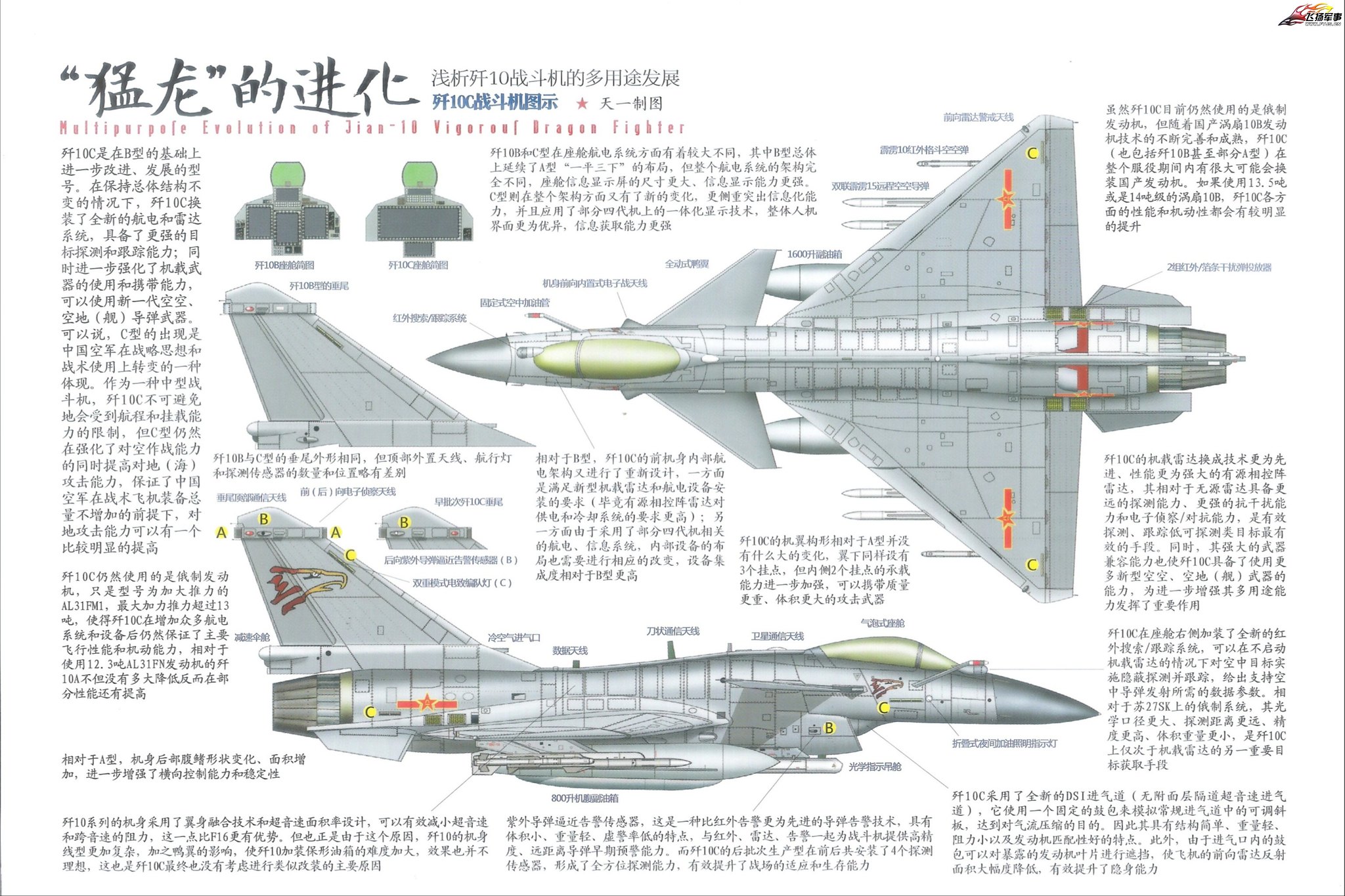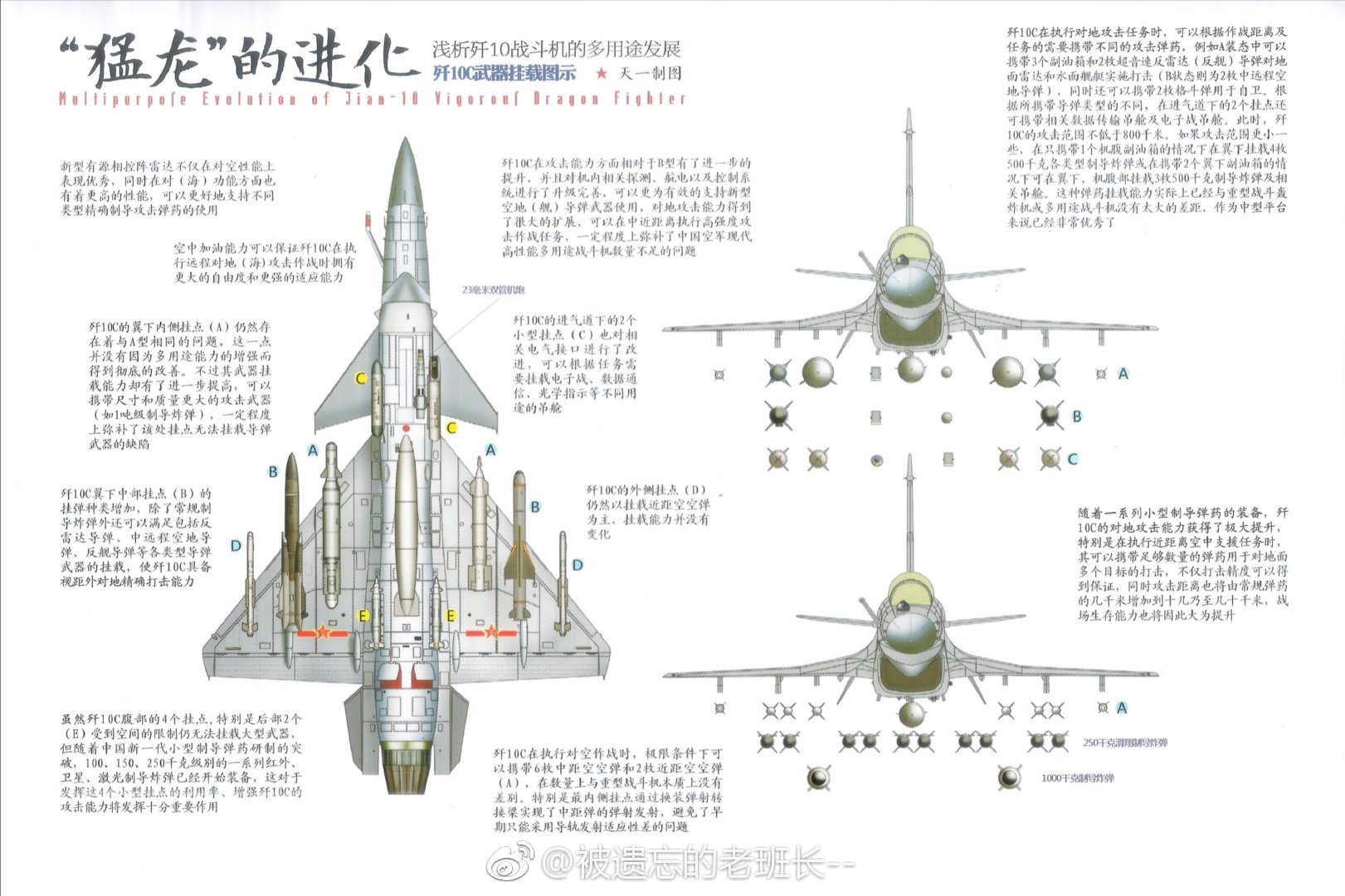by78
General
Some high-resolution magazine scans of J-10C...

Not certain how credible the information contained in the following two images is, but here's a summary:
1) J-10C is an evolution of J-10B. While there are no airframe modifications, avionics and radar systems have been vastly improved, thereby improving its air-to-air as well as air-to-ground/sea capabilities and allowing it to carry more capable weapons.
2) Uses improved AL31FM1, with max thrust exceeding 13 metric tons.
3) While J-10's airframe design (canards + delta) gives it superior supersonic and transonic performance over F-16, this same arrangement makes the addition of conformal fuel tanks difficult. This is why conformal fuel tanks have not been added.
4) J-10C's cockpit abandons the '1+3' arrangement to feature a single large display, borrowing elements from China's 4th-generation fighter design for information management and man-machine interface. The underlying avionics software has been completely re-architected.
5) Features a new AESA radar with low-probability-of-intercept, better detection range, target tracking, thereby allowing J-10C to utilize new generations of air-to-air and air-to-ground/sea weapons.
6) Features a completely new infrared search & track device mounted starboard side forward of the cockpit. Compared to Su-27K's equivalent system, it's more compact and has a larger aperture, longer detection range, and better resolution.
7) One-piece, non-moving DSI inlet reduces radar reflectivity, saves weight, is structurally simple and more mechanically reliable.

1) Hardpoints A: can now carry more weight and munitions of greater dimensions.
2) Hardpoints B: can now carry a wider variety of precision munitions.
3) Hardpoints C: can now mount a greater variety of targeting pods, electronic warfare payloads, and communication pods.
4) Hardpoints D: for short-range air-to-air missiles and feature no improvements.
5) Hardpoints E & C: carrying capacity remains limited due to space constrictions. However, due to China's breakthrough in miniaturized munitions, these four hard points can now carry a new class of precision guided munitions that are now entering service, such as 100-, 150-, 250-kg satellite/laser/infrared-guided munitions. Therefore, these four hardpoints are an important component to the improved strike capabilities of J-10C.
6) Top-right illustration: for air-to-ground/sea missions, configurations A and B can give a 'strike range' (攻击范围) of no less than 800km. Although Configuration C (one center fuel tank + four 500kg munitions + two short-range air-to-air missiles) trades range for more payload, it's pretty decent for a medium-size fighter such as the J-10C.
7) Bottom-right illustration: by carrying miniaturized guided munitions, J-10C's air-to-ground capabilities are vastly improved, especially for close air support missions. These new miniaturized guided munitions enable J-10C to precisely strike multiple ground targets (in a single mission) from standoff distances (10+ km to several tens of km).
8) Bottom-right illustration: for air-to-air missions, J-10C can carry six medium-range air-to-air missiles (configuration A). Unlike on previous J-10 models, the innermost underwing hardpoints are compatible with a new pylon design, which enables the launching of medium-range air-to-air missiles.
P.S. Corrections or additions are welcome.


Not certain how credible the information contained in the following two images is, but here's a summary:
1) J-10C is an evolution of J-10B. While there are no airframe modifications, avionics and radar systems have been vastly improved, thereby improving its air-to-air as well as air-to-ground/sea capabilities and allowing it to carry more capable weapons.
2) Uses improved AL31FM1, with max thrust exceeding 13 metric tons.
3) While J-10's airframe design (canards + delta) gives it superior supersonic and transonic performance over F-16, this same arrangement makes the addition of conformal fuel tanks difficult. This is why conformal fuel tanks have not been added.
4) J-10C's cockpit abandons the '1+3' arrangement to feature a single large display, borrowing elements from China's 4th-generation fighter design for information management and man-machine interface. The underlying avionics software has been completely re-architected.
5) Features a new AESA radar with low-probability-of-intercept, better detection range, target tracking, thereby allowing J-10C to utilize new generations of air-to-air and air-to-ground/sea weapons.
6) Features a completely new infrared search & track device mounted starboard side forward of the cockpit. Compared to Su-27K's equivalent system, it's more compact and has a larger aperture, longer detection range, and better resolution.
7) One-piece, non-moving DSI inlet reduces radar reflectivity, saves weight, is structurally simple and more mechanically reliable.

1) Hardpoints A: can now carry more weight and munitions of greater dimensions.
2) Hardpoints B: can now carry a wider variety of precision munitions.
3) Hardpoints C: can now mount a greater variety of targeting pods, electronic warfare payloads, and communication pods.
4) Hardpoints D: for short-range air-to-air missiles and feature no improvements.
5) Hardpoints E & C: carrying capacity remains limited due to space constrictions. However, due to China's breakthrough in miniaturized munitions, these four hard points can now carry a new class of precision guided munitions that are now entering service, such as 100-, 150-, 250-kg satellite/laser/infrared-guided munitions. Therefore, these four hardpoints are an important component to the improved strike capabilities of J-10C.
6) Top-right illustration: for air-to-ground/sea missions, configurations A and B can give a 'strike range' (攻击范围) of no less than 800km. Although Configuration C (one center fuel tank + four 500kg munitions + two short-range air-to-air missiles) trades range for more payload, it's pretty decent for a medium-size fighter such as the J-10C.
7) Bottom-right illustration: by carrying miniaturized guided munitions, J-10C's air-to-ground capabilities are vastly improved, especially for close air support missions. These new miniaturized guided munitions enable J-10C to precisely strike multiple ground targets (in a single mission) from standoff distances (10+ km to several tens of km).
8) Bottom-right illustration: for air-to-air missions, J-10C can carry six medium-range air-to-air missiles (configuration A). Unlike on previous J-10 models, the innermost underwing hardpoints are compatible with a new pylon design, which enables the launching of medium-range air-to-air missiles.
P.S. Corrections or additions are welcome.

Last edited:

